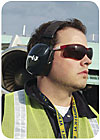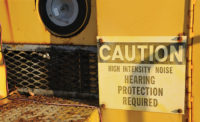
So you think there’s nothing new to learn about using hearing protectors? After all, hazardous noise has been around for a long time; you’ve heard it all before, right? Well, let’s check your hearing conservation know-how with this quick “true/false†test of fact or fiction.
Hearing loss
•Noise-induced hearing loss causes no pain, no visible trauma, and leaves no visible scars. TRUE.From the outside, an ear severely damaged by loud noise looks just like a normal ear. The ears do not bleed, bruise or visibly scar. The damage occurs deep in the cochlea of the inner ear, where receptor cells are irreparably damaged by noise.Hearing loss typically occurs at repeated, unprotected exposures above 90 dB, but most people do not feel pain in the ears until levels reach about 120 dB. This means the range between 90-120 dB is literally a painless hearing loss zone of noise exposures.
•The telltale sign of oncoming noise-induced hearing loss is speech sounding softer. FALSE. The telltale sign is speech sounding distorted and less clear, but not necessarily softer. When loud noise damages hearing, our ability to understand high-frequency sounds of speech is affected. A simple warning such as “Watch out for that pipe!†becomes distorted with a severe high-frequency hearing loss and may sound like, “Wa__ ou_ _or tha_ _i_!†But the volume might not be noticeably different. In fact, many workers with a mild noise-induced hearing loss deny they have lost any hearing, because the volume still sounds acceptable to them.
•Regardless of whether hazardous noise is low-frequency or high-frequency, it will cause a high-frequency hearing loss. TRUE.The noise in your workplace might have a distinctive pitch to it, but long-term noise exposure always affects high-frequency hearing. This is due to the anatomy of the ear. The part of the cochlea most susceptible to damage is the region that detects high-frequency sounds. So regardless of whether the incoming noise is a low-frequency rumble from a turbine, or a high-frequency whistle like a steam release, the result will be a high-frequency hearing loss for an unprotected worker.
•In addition to hearing loss, the most common symptom of noise damage is ringing in the ears. TRUE. Tinnitus (the term for internal ear noises like ringing, buzzing and rushing sounds) is the most common symptom of noise damage, after loss of hearing. In fact, tinnitus is often the ear’s warning signal that the preceding noise was too loud.
Noise exposure
•The permissible exposure limit for noise-exposed workers on a 12-hour workshift is lower than for workers on an 8-hour workshift. TRUE. OSHA’s 90 dBA exposure limit is based upon an 8-hour time-weighted average (TWA). A worker on a 12-hour workshift should use an exposure limit of 87 dBA. Longer exposure times require lower exposure limits to be safe. For this reason, workers on extended workshifts also require hearing protectors with greater attenuation.•Any worker exposed to noise under the OSHA limit of 90 dBA TWA is safe. FALSE.OSHA does indeed define its permissible exposure limit at 90 dBA TWA, but clearly states this level is intended only to protect most workers — not all. A significant number of workers will still suffer permanent hearing loss at exposure levels of 85-90 dB TWA.
•Noise is typically measured in A-weighted decibels (dBA). A-weighting is a correction added to noise measurement equipment to mimic the human ear. TRUE. Most sound level meters and noise dosimeters have an optional A-weighting switch, allowing the user to apply an internal filter that corrects the measurements. These A-weighting corrections mimic the frequency sensitivity of the human ear, which is not as sensitive to low- and high-frequency sounds as it is to mid-frequency speech sounds. OSHA advises taking your noise measurements in A-weighted decibels in hearing conservation programs.
Hearing protectors
•According to OSHA regulations, noise-exposed workers are allowed to select their own hearing protectors. TRUE… but from a choice of protectors with adequate attenuation. A good practice is to provide workers with single-use and multiple-use earplugs, as well as a selection of earmuffs.•Foam earplugs offer more protection from noise than earmuffs. TRUE,with one qualifier: Properly fit foam earplugs offer more protection than the typical earmuff. A well-fit earplug seals the ear canal from hazardous noise, and is less likely to allow acoustical leaks than an earmuff. This is evident in the higher attenuation values of foam earplugs.
•The Noise Reduction Rating (NRR) of a hearing protector should be cut in half to estimate how much protection workers will achieve in the real world. FALSE. Field studies show that many workers achieve the rated attenuation, particularly when they receive one-on-one training in proper fit of the hearing protector. Needless de-rating of hearing protectors can result in overprotection.
•Wearing an earmuff simultaneously over an earplug doubles the noise attenuation. FALSE. There is a ceiling effect that limits the amount of hearing protection we can achieve. Once we reach that limit, adding more protection offers no additional benefit.
•Earmuffs cannot be worn over safety glasses without causing a significant decline in attenuation. FALSE.The determining factor is the width of the eyeglass frame where it meets the earmuff cushion. Thin frames (thickness of 2 mm or less) cause very little obstruction to the seal, resulting in no measurable change in attenuation of the earmuff.
•In hazardous noise, an earmuff with AM/FM radio can still be safely worn without compromising hearing. TRUE.Some radio earmuffs are made with a built-in limiting circuit: No matter how high the volume control, the maximum output of the radio will not exceed a safe 82 dB. When worn in workplace noise levels even up to 100 dB, the attenuation of the earmuff and the limiting circuit of the radio combine to prevent noise exposures from exceeding 85 dB. In a high-noise job that is also repetitive or monotonous, a radio earmuff can add significantly to worker satisfaction and enjoyment, without sacrificing hearing protection.
